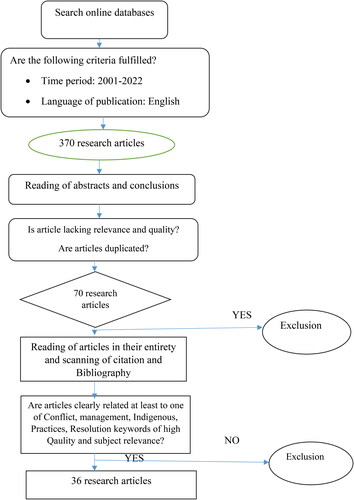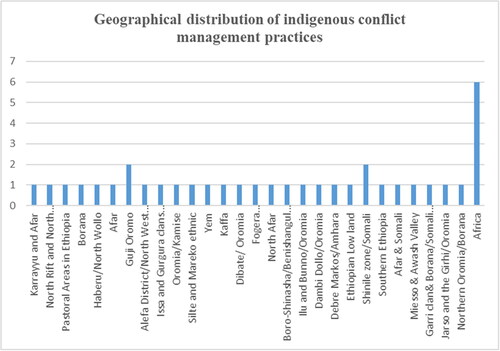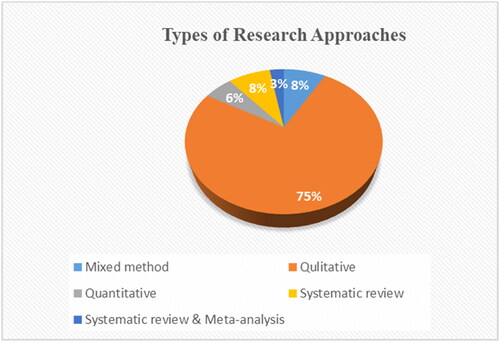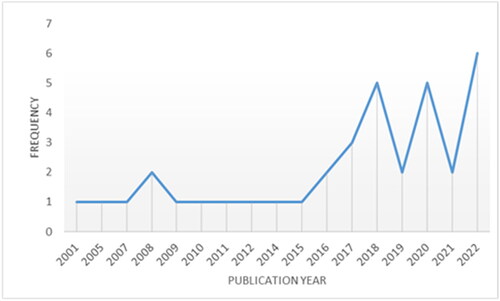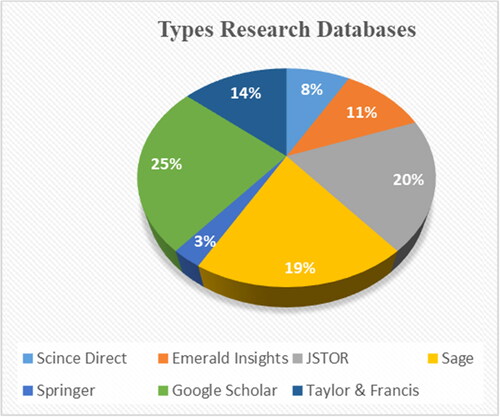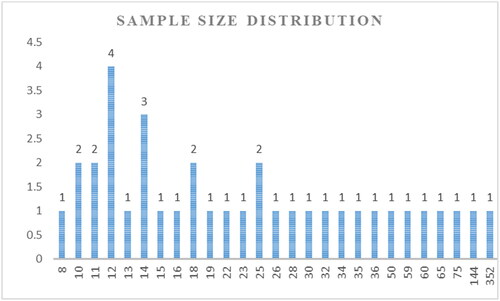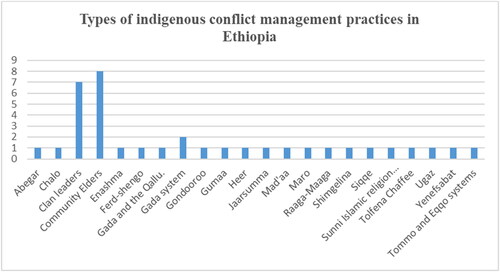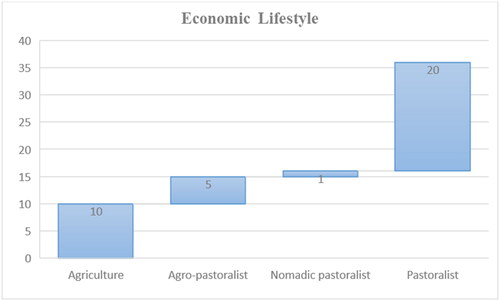Abstract
This research aims to examine recent writing on the dynamics of indigenous conflict management practices in Ethiopia to review the concept and create a more thorough theoretical description from a conceptual perspective. The study demonstrates that there are scattered studies across countries about the conceptual application of dynamics of indigenous conflict management practices in Ethiopia within the scope of the review (2001 to 2022). Because of this, whether the firm is large or little, for profit or not, a thorough understanding of the dynamics of indigenous conflict management practices in Ethiopia is essential for all levels of modern organizations as an alternative option. To help practitioners build and implement dynamics of indigenous conflict management practices in pastoralist and agricultural ways of economic lifestyle comparatively with statutory law. Analyzing the current state of research and management orientations in this field will be useful to the scientific community and society at large. Many methodological (exclusive search) constraints exist in this review, which may limit how well it can be used with additional case studies. The dynamics of indigenous conflict management practices in Ethiopia are essential parts of conflict resolution relevant to formal conflict resolution mechanisms in most of the pastoral communities in Ethiopia. It is the first of its type to use a systematic review analysis of the dynamics of indigenous conflict management practices in Ethiopia to demonstrate how the concepts relate to managing conflict conventional by carefully reviewing a large body of research in this field. Both ideas have not been investigated or addressed before. A full understanding of the current state of indigenous conflict management research conceptualization needs the attention of policy crafters for those communities that developed the system through generational paths for centuries in Ethiopia before formal conflict resolution or modern ways of solving conflict.
1. Introduction
Indigenous African knowledge of establishing and upholding peace is not well known and has not been heavily incorporated into the predominant contemporary conflict settlement mechanisms. The Guji-Oromo are acutely conscious that the upkeep of peace (nagaa) within their community, between them and God, as well as between them and their natural and social environments, is essential to their continued existence as a society (Debelo & Jirata, Citation2018). Africa needs effective resource management methods to reduce the ongoing security issues and conflicts brought on by resource ownership (Olanrewaju et al., Citation2020). Indigenous conflict management practices interventions used both formal and informal means to cope with the conflict. The formal mechanism, through local governments, took over the boundary demarcation project, while the informal/indigenous dealt with the contested resource-based conflict. The indigenous mechanism of elders has proven less effective in addressing the scarce resource issue and has remained a challenge to local peace. Conflict management intervention was conducted to address the root causes of the issue after understanding the insecurity situations in the border regions between the warring groups, Mareko and Silte (Yilma & Yilma, Citation2016).
Designing efficient organizations that track land conflicts and support traditional leaders in handling conflicts is a crucial step in conflict resolution mechanisms (Bekele et al., Citation2022). The Silte of southern Ethiopia is among those ethnic groups with their conflict resolution mechanism. The investigation explained the main sources of conflict in the study area and the indigenous methods used to resolve them, including the Baliq conflict resolution institution’s criteria for choosing an elder, as well as the indigenous laws of the study area (Lemu Bekelcha & Eticha Sefera, Citation2021). These primarily finding from frequent modifications to the boundaries between various pastoral groups’ access to external resources after alterations to their internal administrative borders. Most often, policies have neglected conventional methods of resource management, escalating interethnic tensions (Tache & Oba, Citation2009).
The function of indigenous conflict resolution in the framework of a mediation council between two kebeles in the Fogera District. Conflict resolution has benefited greatly from the traditional committee of conflict resolution. Members of the mediation committee made efforts to manage the mediations, which directly affected the decision that would be made. The instances demonstrated that the majority of the council members favored a sustainable win-win solution to the issue (Assefa, Citation2020).
The Oromo of the Dibate District has its conflict resolution techniques. When conflicts occur between individuals or communities, they each have their indigenous conflict resolution mechanisms. In Dibate District, homicide, theft, robbery, rape, kidnapping and rivalry over grazing and farming lands, water and hunting grounds are the most frequent causes of conflict. There may be internal or tribal disputes. Therefore, the Tolfena Chaffee Chanicho has greater acceptance among the Oromo of the Dibate District community as an organization to manage such conflict. Because they administer just punishments, the council of elders or selgie, is highly regarded and accepted. The Oromo Gada ideals are so deeply ingrained in Oromo culture that the rulers were unable to completely untangle them. Likewise, the Oromo Gada System has experienced a resurgence in the years since it was registered with the UNESCO Gada Values. To sum up, guma is an entirely traditional system for achieving harmony in which elders hold a dominant position. Similarly, everyone in the community, including artisans, engages in the process (Wakgari et al., Citation2022).
Indigenous conflict resolution and management are less complicated and time consuming, with participants in conflict solving their problems and handling their affairs in more acceptable ways. However, the role of these vital organizations in resolving disputes is dwindling over time. In-depth knowledge of indigenous rangeland conflict management and resolution methods in Ethiopian pastoral areas. The Elder’s council should be legally recognized, and mechanisms to enable traditional institutions to coexist with modern government structures are also required (Mohammed et al., Citation2017). It is crucial to increase Afar people’s awareness, particularly among elders and makaban. However, the formal justice system must be made more effective to manage criminal cases that occur between individuals and clans before the government recognizes the maro and determines the boundaries of its jurisdiction (Gebre-Egziabher, Citation2014).
The Afar local assemblies serve as indigenous courts, with rules derived from mutually binding value systems and common norms to resolve interethnic conflict. The modern administrative and legal apparatuses and the traditional organizations continue to work in harmony. Traditional systems have remained resilient and influential due to the predominance of complementary rather than competitive relationships between the state and these systems. Therefore, this review identified the dynamics of indigenous conflict management practices in Ethiopia based on the limitations of scholars’ work in this area and we proposed future directions for researchers interested related to this topic.
Based on the fundamental flaws of past reviews and research articles written by academics with various conceptual levels, this study intended to address the following critical review questions.
What is the relevance of indigenous conflict management practices across different parts of Ethiopia in a given time interval?
What types of research approaches have been used in those articles to collect research data?
In which databases were journal articles of scholars published?
What are the types of indigenous management conflict approaches used in their past research studies?
Do indigenous conflict management practices commonly apply in a different part of Ethiopia from those articles?
In which year were most of the indigenous conflict management practices research articles attracted the emphasis of scholars?
2. Review of related literature
Social movement theories dominated the views used to analyze the dynamics and processes of intergroup competition. We combine the sociological component of identity framing and processes with the political analysis of inter-group competition to improve the methodological robustness of the analysis (Hussein & Beyene, Citation2015). Natural resource management institutions affect the incentives for conflict or cooperation; the outcomes of these interactions influence future conflict risk, livelihoods and resource sustainability (Ratner et al., Citation2017). Violence and ethnic conflict are commonplace in remote areas with limited access to a central authority and scarce natural resources like arable land and water. In several African nations, studies have examined the convergence of economic, political and ecological marginality (Adano et al., Citation2012). Investigates the indigenous conflict management and resolution mechanisms that have been in use among the pastoral communities in the Shinile zone. It also makes an effort to characterize the nature and types, underlying causes and effects of conflicts among pastoralists using a range of resources (Mammo et al., Citation2008).
There are some cases where elements of the indigenous systems today appear to be incompatible with those of the contemporary nation-states that have established control over the societies and groups in which they were active (Fred-Mensah, Citation2001). Although there are numerous instances of these indigenous peacebuilding and conflict management strategies used around the world, nobody has yet attempted to empirically test which approaches to conflict management are most effective, nor has the literature sufficiently addressed the contexts in which these strategies are most useful (Lundy et al., Citation2022). It makes the case that encouraging local dialogue among various communal identity-based groups can rekindle intergroup cooperation and lessen prejudices against other groups, thereby lowering the likelihood of communal conflict escalation (Smidt, Citation2020). In the Horn of Africa, pastoralist access to and use of shared grazing resources is increasingly accompanied by violent conflict over the resources’ declining availability and restricted access. This occurs as traditional customary institutions (sets of rules) for managing commons become compromised as a result of outside influences and actors that significantly alter both resource availability and conceptions about who is subject to traditional rules governing commons, particularly rules associated with exclusive (Unruh, Citation2019).
The nomads usually follow their cattle across the region in search of green pastures and access to water, and they do not only travel in Kenya. Conflicts over water and pasture arise as a result of their repeated crossing of international borders into and out of Uganda, Ethiopia, Sudan and Somalia. The financial stability of families and internally displaced people have been severely impacted by resource competition in a fragile economy (Kumssa et al., Citation2009). It is necessary to pay more attention to the role that various knowledge types play in conflict resolution to cast more light on potential flaws in the resolution procedures. This could act as a foundation to help resolve conflicts in a way that is more long-lasting, long-term focused and thus more viable. We conclude that the three pieces of literature contribute to one another’s understanding across disciplinary boundaries and can be used to create more sophisticated theories of how knowledge is used in conflict analysis and resolution (Stepanova et al., Citation2020).
The most typical conflicts that are resolved through indigenous methods involve theft and land-related issues. Indigenous dispute resolution techniques like Shimglina, Yezmed, gelagay, yenefsabat, mahber, zikir and sunbete are frequently used. Different factors compelled residents to use indigenous dispute resolution techniques (Yitayew et al., Citation2020). In some parts of Ethiopia, the Jaarsumma practices in the Western Oromia village of Dambi Dollo serve as an indigenous method of resolving disputes. Examining the Oromo-Jaarsummaa level of use of indigenous conflict resolution was the goal of the research. To preserve it as a cultural heritage, working on the sustainability of Jaarsummaa should be broadly practiced (Terfa, Citation2018).
Numerous tribal groups have created mechanisms for resolving conflicts in Ethiopia. One of those with its system for resolving conflict is the ethnic community of Yem in southwestern Ethiopia (the Chalo judicial system). The so-called Chalo judicial system, which is based on the traditions and customs of the Yem people, is one of the unique indigenous conflict settlement mechanisms. The main players in the Chalo judicial system are three judges (Mengagna, Aulongagna & Kongagna) and twelve tribal leaders (juries) from various ethnic groups (Nigatu & Jobir, Citation2022). Other reasons for conflict in the pastoral community included historical and political factors, drought, property alienation for investment and youth idleness. Furthermore, almost all of the study’s informants used and favored native conflict resolution methods that have a strong pastoral community foundation. Clan leaders, religious leaders and community elders are important participants in indigenous dispute-resolution processes (Muluken, Citation2020). In contrast to primordial and environmental conflict theories of pastoralist violence, we shed light on the changing political rationality of inter-group conflicts by retracing the multiple impacts of state-building on pastoral land tenure and resource governance, peacemaking and customary authorities and competition for state resources (Hagmann & Mulugeta, Citation2008). The accessibility and abundance of natural resources are under a lot of pressure from trends in consumption, demographics, environmental degradation and socio-political dynamics. Land governance for commercial agricultural investment is a major source of strife in many nations. These disputes are intricate, and their causes go beyond a lack of resources to include access and rivalry problems (Tufa et al., Citation2018).
3. Research method
Finding papers that define or conceptualize the dynamics of indigenous conflict management practices in Ethiopia required a systematic review of the literature, which was used in this research. Because of its comparative benefits, we decided to conduct a systematic review of the literature rather than a narrative or meta-analysis. Some of the attributes of this method have been adopted by the social sciences. It has lately been thoroughly examined to determine whether the method is appropriate for the discipline of organizational behavior. A systematic review assists in building a reliable knowledge foundation by compiling data from various studies. This research examines the differences and similarities between these concepts, which are covered in this review.
3.1. Search strategy
A clear, well-documented research process with standards for article inclusion and exclusion was made feasible by the systematic identification of pertinent research articles. The systematic review process includes the following steps: formulating research questions, establishing standards for collecting literature, choosing inclusion and exclusion criteria, developing a thorough search strategy for locating literature, developing a codebook for classifying and describing literature, coding the literature and synthesizing the literature. This review discusses the various ways that the notions of dynamics of indigenous conflict management practices have been explored in researchers’ works, looking at the literature to see if there is a strong relationship between them. Using the search strategy, the majority of research papers that combine the dynamics of indigenous conflict management practices were discovered. To accomplish this, inclusion and exclusion standards for this evaluation were developed.
3.2. Sample selection process
In the original search, 370 English-language research publications were discovered. In , the selection process flow diagram is depicted in broad outlines.
3.2.1. Selection of databases
The study employed a three-step method to locate academic research publications. As a starting point, we selected significant datasets for business, management and social science. To find relevant articles for the review, we searched seven major academic databases that are Scopus-indexed: Emerald Insight, Taylor and Francis, Springer, Sage, Google Scholar, Wiley Online Library, JSTOR and Science Direct. These databases included articles related to the dynamics of indigenous conflict management practices in Ethiopia. By evaluating each article downloaded using a systematic literature review strategy, the databases were ultimately selected mainly based on the characteristics of the topic (dynamics of indigenous conflict management practices in Ethiopia).
3.2.2. Inclusion and exclusion criteria
Inclusion and exclusion criteria were used to conduct the review. The search variable set, publication year, language and search boundary make up the inclusion criteria. The social sciences, management and management journals that have undergone peer review and are widely respected were the search boundary. The search technique concentrated on academic articles published between 2001 and 2022.
The year 2001 was selected as the baseline for the earliest period of interest to produce a publication and further shift the paradigm in terms of technology and human resource management strategies. Only research articles published in English were included in the study search. To conduct their research, researchers used search engines that used the Boolean method and the words ‘dynamic’, ‘indigenous’, ‘conflict’, ‘management’, ‘resolution’ and ‘practices’.
Relevance, excellence and duplication are the exclusion criteria. This was achieved by carefully analyzing the abstracts and conclusions of the downloaded article databases used in this investigation. To improve the findings of this review, the study excluded unpublished articles, article contents, book reviews, Miscellaneous, Books, book chapters, Working paper series and conference papers. The relevance of the articles was determined by determining whether they fit a keyword used as a search string. By assigning codes to each article and using manual detection, duplicate articles were eliminated.
Following a thorough screening process by the researchers, we established a publication pool of 370 articles after identifying and eliminating duplicates. Using a number of inclusion and exclusion criteria, we screened these papers. The inclusion and exclusion criteria were met by 35 articles in total. A systematic, reliable, replicable and transparent approach to data gathering and analysis of the paper used during article selection for a systematic review is created by the review technique.
3.3. Data analysis
Concerning review questions that were predetermined at the first stage of the review steps, we applied a descriptive and content analysis. Using the data mining form’s categories, a descriptive analysis was carried out. To do this, the review matrix was tabulated, especially for the discussion of research features findings utilizing points such as databases, kind (conceptual, empirical or review) and level of analysis. The descriptive analysis aids the research characteristics subsection and gives the reader a quick overview of the reviewed publications in this study. In addition, content analysis was employed as a data analysis technique. The publications addressed encoding-related topics, and a manual interpretative approach was employed to examine the study’s outcomes. The first paragraph of this section provides an overview of the 35 identified journal articles’ case topics, contributions, constraints, research methodologies and distribution by years and journals. The next section goes into detail on how technology and human resource management techniques have been conceptualized by past researchers.
4. Result and discussion
This section begins by explaining the conceptual links between the 36 selected journal research articles by explaining the country/regional-wise distribution, study approach-wise distribution, year-wise distribution, database-wise distribution, sample size distribution, case-wise distribution and journal-wise distribution. Following that, this section explores the conceptualizations of dynamic indigenous conflict management practices in Ethiopia conducted by previous research efforts.
4.1. Country/regional wise distribution of articles
displays the publication distribution of the 36 selected research articles by country/region. Six of the 36 articles considered or the bulk of them, were examined in different African countries. In these regions, two investigations on the dynamics of indigenous conflict management practices were conducted. The following research articles were published one in each of the following regions: Afar, Borana, Damb Dollo, Fogera, Illu and Bunno, Kaffa, Miesso and Awash Valley, North Rift and Northeastern, Northern Oromia/Borana, Oromo of Dibate, Somalia and Yem. This could imply that there is a regional/woredas requirement for future researchers to consider a geographic gap while investigating the dynamics of indigenous conflict management practices in Ethiopia. More than 80 ethnic groups in Ethiopia, each of which is said to have indigenous conflict management practices, have been the subject of a very small number of studies on the dynamics of indigenous conflict management practices in Ethiopia.
4.2. Types of research approaches
shows 36 studies that were picked for in-depth literature review and appeared in a range of reputable journals. In these articles, the dynamics of indigenous Ethiopian conflict management practices were examined. The study provided information on the proportion of the 36 research publications that used the various research procedures or types that were mentioned above for the benefit of the scientific community and practitioners. A qualitative research methodology was utilized in 75% of studies on the approaches used by earlier researchers to examine perspectives on the dynamics of conflict management practices. Additionally, academics used a systematic review and a mixed method approach as their second study approach, each contributing 16% of the total. While quantitative approaches account for 6%, and systematic reviews and meta-analyses account for 3%, respectively. In light of this, we conclude that the best method was used by researchers who focused on the dynamics of indigenous Ethiopian conflict management practices and was a widely used qualitative research approach.
4.3. Year-wise distribution of articles
This research article was divided into groups from 2001 to 2022 based on the year it was released to discover trends in the dynamics of indigenous conflict management practices in Ethiopia. depicts how the number of publications on indigenous conflict management practices in Ethiopia increased between 2001 and 2022. However, between 2015 and 2018, the number of research articles on indigenous conflict management practices in Ethiopia expanded dramatically. However, the study shows that from 2019 to 2022, there would be an exponential spike and decrease. In 2022, conversely, most research articles on this issue were published. This demonstrates the importance of increasing purpose and interest in the dynamics of indigenous conflict management resolution systems.
4.4. Types of research databases
This analysis identified the top academic research databases between the years 2001 and 2022 (). The majority of academics’ research papers (25% of the 36 databases) were published via Google Scholar. JSTOR and Sage, which each account for 20% and 19% of research papers across a specific period relevant to the dynamics of indigenous conflict management practices in Ethiopia, are the second and third-best research databases, respectively. However, academics who accessed Springer (3%), Science Direct (8%), Taylor and Francis (14%) and Emerald Insights (11%) during the review period considered articles on the dynamics of indigenous conflict management practices in Ethiopia in the scientific community. We can infer that Google Scholar paid more attention than other research databases to studies on the dynamics of indigenous conflict management practices in Ethiopia.
4.5. Journal-wise distribution of articles
This description’s goal is to track the distribution of papers between 2001 and 2022 based on the titles of journals that are thought to have published research on Ethiopia’s indigenous conflict management practices in Ethiopia. For research publications on the dynamics of indigenous conflict management practices in Ethiopia under various domains, we selected 36 reputable journals with peer reviews and Scopus indexing (). The scientific community may find solace in this number if they are concerned about selecting a publisher for future research on the dynamics of indigenous conflict resolution practices in Ethiopia. Two publications on the dynamics of indigenous conflict management were approved by two journals on an equal basis from among these reliable studies (see ). As listed in (), each of the remaining journals accepted a single issue. We conclude that if there is continued interest in Ethiopia’s indigenous conflict management dynamics, additional journal names besides those used for this study may be found by scholars.
Table 1. List of journal names.
4.6. Sample size-wise distribution
There were 36 articles on the dynamics of indigenous conflict management practices in Ethiopia that were found in various databases between 2001 and 2022 (). Very few of the studies used in this study have sample size distribution ranges between 50 and 352. The majority of the research articles we evaluated had sample sizes ranging from 8 to 36 because they used qualitative research methodologies, which by their very nature call for fewer participants. In conclusion, accuracy and representativeness rise with sample size, necessitating a sample size increment for this type of issue for future research.
4.7. Types of indigenous conflict management practices in Ethiopia
The distribution of the 36 chosen research articles by categories of indigenous conflict management strategies in Ethiopia is shown in . Eight out of the 36 research articles included for this study in Ethiopia showed that the majority of indigenous conflict management techniques relied on Community Elders-based resolutions. Comparatively, Clan Leaders and the Gada system in various regions of Ethiopia have been the focus of 7 and 2 research articles, respectively, published between 2001 and 2022. Finally, one study article each on indigenous conflict management strategies in Ethiopia Abegar, Chalo, Enshama, Ferd-sheng, Gada & Qallu, Gondooroo, Gumaa, Heer, Jaarsumma, Mad’aa, Raaga-Maaga, Shimgelina, Siqqe, Sunni Islamic religion, Tolefena chaffee, Ugaz, Yenefsabat and Tommo and Eqqo system. As a result, we conclude that most research publications on the dynamics of indigenous conflict management practices in Ethiopia were used by community elders and clan leaders in this study review between 2001 and 2022. Future researchers are asked to recognize the limitations of the work of earlier academics due to the use of indigenous conflict management practices by other Ethiopian areas and ethnic groups.
4.8. Economic lifestyle of study areas
This investigation was conducted to determine whether economic practices were to blame for or not disputes between Ethiopian regions or ethnic groups (). As a result, studies conducted between 2001 and 2022 using 36 research publications on the subject of indigenous conflict management strategies in Ethiopia identified resource-related issues as the main cause of the majority of conflicts. Most of the violence was experienced by people living a pastoralist way of life in Ethiopia, which is represented by 20 out of 36 research articles chosen between 2001 and 2022. This is frequently due to ethnic conflict and pasture land issues, which are included in most academic studies.
As a result, 10 and 5 out of 36 research articles reviewed identified agriculture and agro-pastoral economic lifestyle practices as the second and third causes of conflict in those selected case locations in Ethiopia. Additionally, from 2001 to 2022, just one study by scholars relevant to the dynamics of indigenous conflict management practices in Ethiopia dealt with nomadic pastoralists. We conclude that pastoral communities and an agriculturally based economic lifestyle constituted the majority of the indigenous conflict management practices used in Ethiopia.
4.9. Discussions
Indigenous conflict management procedures have the potential to be a catalyst for increased wellbeing and beneficial social change in the Alefa region of Gondar because they are more adaptable than formal judicial systems. A typical approach to resolving indigenous conflicts is to create consensus through inclusive indigenous communities and beyond. The potential role of the Oromo Gadaa and Siqqee system of democracy in the growth of a democratic international liberation movement of colonized countries inside the Ethiopian Empire to topple the Tigrayan-led Ethiopian terrorist government and replace it with an independent international democratic state in the Horn of Africa based on indigenous democratic principles (Jalata, Citation2013).
One of the many indigenous Oromo organizations, Gondooroo, has only ever been used to end blood feuds. The literature lacks a psycho-social analysis of Gondooroo despite its widespread use and multi-disciplinary character. This article provides a psycho-social viewpoint on Gondooroo intending to fill this gap and maximize Gondooroo’s potential contributions to peacebuilding, justice administration and conflict resolution (Boru, Citation2016). a structure established to direct the Oromo people’s social, political, economic and religious life in Ethiopia. It also manages resources like water and aids in community and interpersonal dispute resolution. To incorporate the customary mechanisms of conflict resolution into the enactment or application of statutory laws, methods should be pursued to learn about them from the Lubas, elders informed about the Gadaa system (Edossa et al., Citation2007). It indicates that Ethiopian authorities support the operation of indigenous conflict management access options, the effective operation of customary courts and the penalization of opportunistic actors to address inter-ethnic conflicts (Beyene, Citation2017).
In Amhara and Tigray’s indigenous conflict resolution practices, women have a tangential role to perform. Women play a significant role in resolving disputes between Oromo clans in the Oromia region by intervening and requesting reconciliation through the institution known as Siqqe. Women in Somalia take on a variety of responsibilities before, during and after conflicts. Women of South countries and nationalities play a variety of roles in resolving disputes, either alongside men or by themselves and organizations based on men do so on an equal basis regardless of sex (Bayu, Citation2020). It is viewed as being archaic and outdated by them. Since the Ugaz is in charge of handling all facets of societal issues like conflict resolution, there should be a revitalization and appreciation of indigenous community organizations like it. the part played by women in social institutions and rituals among the Issa and Gurgura clans of the Somali ethnic group, their involvement in conflict resolution and indigenous conflict resolution, and their participation in these activities (Tadesse et al., Citation2010).
In Kaffa society, Shimgelena, Tommo and Eqqo systems are the most frequently used conventional dispute resolution techniques. Tommo and Eqqo are native to Kaffa society, even though shimgelena is also extensively used in other communities in Ethiopia (Wolde, Citation2018). Enashma, a traditional Boro-Shinasha organization for resolving disputes, was essential in preserving tranquility and security in the study area. As a result, the Enasham establishment of Boro-Shinasha in Bullen Woreda is still well-known and esteemed in the neighborhood. Enashma institution also has some flaws, such as gender bias, low female involvement and no set standard for determining pay (Million Esho, Citation2021). Abegar’s indigenous way of conflict resolution is being practiced in Haberu Woreda, North Wollo, to restore harmony and peace to the area. Some of the conflicts that are presented and resolved in the community include interpersonal, homicidal, inter-group conflicts brought on by the kidnapping of girls and women, violations of social norms, theft, disagreements over a girl’s claims, rivalry over possession of land and drunkenness (Yimer, Citation2021).
5. Conclusion
The purpose of this systematic review was to review contemporary literature on the dynamics of indigenous conflict management practices in Ethiopia investigated by different research scholars’ perspectives from (2001 to 2022). Most of the previous scholars’ papers commonly focused on qualitative research approaches and geographically very few research investigated indigenous conflict management practices in Ethiopia. It is difficult to find studies on indigenous conflict management practices in Ethiopia compared with some other countries in Africa. We found that most of the studies were conducted in pastoralist and agricultural ways of economic lifestyle communities about indigenous conflict management practices. In this review, no studies were conducted about indigenous conflict management practices except in the case of Debre Markos town. The dynamics of indigenous conflict management practices have been not investigated within a given period specified in most Ethiopian regions as compared with the ethnic group found in Ethiopia.
6. Implications
This study has significant conceptual contributions to the scientific community and practitioners. The study offers a comprehensive systematic review of 36 identified research articles in management and organizational behavior insights to reveal how scholars have explored this concept so far and presents a route for future research agendas. Besides, this study contributes to basic knowledge of conflict management practices from indigenous ways of handling conflict between 2001 to 2022. Mainly this study contributes by identifying the relevance of indigenous conflict management practices in Ethiopia less researched in reputable journals and requires exploring the dynamic significance of customary law along with statutory law. Reviewing key insights from existing scholars’ conceptualizations of the paradigm and supporting that by the conceptual foundations, brief definitions, broad in scope and views, have been derived to advance empirical research on the dynamics of indigenous conflict management practices. For professionals, this research demonstrates the favorable outcomes organizations can derive by having a proper understanding of the dynamics of indigenous conflict management practices in Ethiopia particularly in those study areas and hopefully extending to a different part of the region. Thus, dynamics of indigenous conflict management practices will play an imperative role in that concern in the future too; this review will benefit firms comprehend that enhanced.
7. Limitations
Although, a systematic review also has methodological limitations, including the level of accuracy and preferences not being the same with different scholars. To overcome this type of limitation, we focused on top-known research databases trusted broadly by scholars pertinent to the discipline and the topic of the issue under review. Even if some scopes might have been missed, we trust our conclusion found a reasonable acceptance of redundancy in the databases that we used for this study due to our focus only on the specified scope.
8. Future research direction
We recommend that future researchers investigate by relaxing the time and considering the geographical gap identified in this study. Specifically, a future researcher may contribute to the literature older than this study and clarify our findings. Importantly, the findings of this review confirm that despite the relatively established body of literature, there is a lack of direction in addressing indigenous conflict management practices in the majority of the ethnic group across different regions and woredas in Ethiopia. It is important if this type of conflict resolution practice may be applied to urban areas of Ethiopia besides the rural or pastoral communities.
Abbreviations
Not applicable in this document.
Ethical approval and consent to participate
Not applicable.
Consent for publication
Not applicable.
Disclosure statement
No potential conflict of interest was reported by the authors.
Additional information
Notes on contributors

Robson Mekonnin Shiferaw
Mr. Robson Mekonnin Shiferaw is an assistant professor at Haramaya University, Ethiopia and a Ph.D. candidate in Management at Jimma University, College of Business and Economics, Department of Management.

Kenenisa Lemi Debela
Dr. Kenenisa Lemi Debela is an Associate Professor of Management at Jimma University, College of Business and Economics, Department of Management. Dr. Kenenisa pursued his BA degree in Accounting and Finance and Masters of Business Administration (MBA) from Jimma University in 2006 and 2010 respectively and PhD in Management Studies from Punjabi University, India in 2016. Dr. Kenenisa Lemi is engaging in teaching and learning, research and community service endeavor. He Published 41 articles at National and International Journals. Dr. Kenenisa was engaging in administrative activities as head of the department of Accounting and Finance, Ethics officer, Vice Dean, Dean of the College of Business and Economics and Vice President for Administration and Students’ Affairs of Jimma University. Dr. Kenenisa is a coordinator and Co-PI for SUSTAIN Project, a collaborative project between Jimma University, Mizumbe University and Norwegian Business School. Jimma University, Jimma. Email: Corresponding Author: [email protected]
References
- Adano, W. R., Dietz, T., Witsenburg, K., & Zaal, F. (2012). Climate change, violent conflict and local institutions in Kenya’s drylands. Journal of Peace Research, 49(1), 1–15. https://doi.org/10.1177/0022343311427344
- Assefa, H. (2020). The role of indigenous institutions in resolving land related conflicts: A case study of two kebeles in Fogera Woreda, North-West Ethiopia. International Affairs and Global Strategy, 1–8. https://doi.org/10.7176/IAGS/83-01
- Bayu, E. K. (2020). Gender and conflict management: The role of women in indigenous conflict resolutions for peace building in Ethiopia: A systematic review and meta-analysis. International Affairs and Global Strategy, 80, 1–10. https://doi.org/10.7176/IAGS/80-01
- Bekele, A. E., Drabik, D., Dries, L., & Heijman, W. (2022). Large-scale land investments and land-use conflicts in the agro-pastoral areas of Ethiopia. Land Use Policy, 119(May), 106166. https://doi.org/10.1016/j.landusepol.2022.106166
- Beyene, F. (2017). Natural Resource Conflict Analysis among Pastoralists in Southern Ethiopia. Journal of Peacebuilding & Development, 12(1), 19–33. https://doi.org/10.1080/15423166.2017.1284605
- Boru, G. (2016). Gondooroo as an indigenous method of conflict resolution and justice administration. Journal of Philosophy, Culture, and Religion, 23, 65–73.
- Debelo, A. R., & Jirata, T. J. (2018). “Peace is not a free gift”: Indigenous conceptions of peace among the Guji-Oromo in southern Ethiopia. Northeast African Studies, 18(1–2), 201–230. https://doi.org/10.14321/nortafristud.18.1-2.0201
- Edossa, D. C., Awulachew, S. B., Namara, R. E., Babel, M. S., & Gupta, A. D. (2007). Indigenous systems of conflict resolution in Oromia, Ethiopia. Community-Based Water Law and Water Resource Management Reform in Developing Countries, 146–157. https://doi.org/10.1079/9781845933265.0146
- Fred-Mensah, B. K. (2001). Indigenous African conflict management schemes: Analyses and references. A Current Bibliography on African Affairs, 32(1), 1–26. https://doi.org/10.1177/001132550103200101
- Gebre-Egziabher, K. A. (2014). Dispute resolution mechanisms among the Afar People of Ethiopia and their contribution to the Development Process. The Journal for Transdisciplinary Research in Southern Africa, 10(4), 152–164. https://doi.org/10.4102/td.v10i4.94
- Hagmann, T., & Mulugeta, A. (2008). Pastoral conflicts and state-building in the Ethiopian lowlands. Africa Spectrum, 43(1), 19–37.
- Hussein, J. W., & Beyene, F. (2015). Dynamics of institutionalized competition in the geography of inter-ethnic rivalry: The case of the Jarso and the Girhi in Eastern Ethiopia. International Area Studies Review, 18(2), 138–163. https://doi.org/10.1177/2233865914565930
- Jalata, A. (2013). Democracy and the liberation of Ethiopian colonial. December.
- Kumssa, A., Jones, J. F., & Williams, J. H. (2009). Conflict and human security in the North Rift and North Eastern Kenya. International Journal of Social Economics, 36(10), 1008–1020. https://doi.org/10.1108/03068290910984786
- Lemu Bekelcha, K., & Eticha Sefera, A. (2021). Baliq: Indigenous conflict resolution mechanism among the silte people: The case of Silti Woreda, Kibet Town. Novateur Publications International Journal of Innovations in Engineering Research and Technology, 8(1), 2394–3696.
- Lundy, B. D., Collette, T. L., & Downs, J. T. (2022). The effectiveness of indigenous conflict management strategies in localized contexts. Cross-Cultural Research, 56(1), 3–28. https://doi.org/10.1177/10693971211051534
- Mammo, A. M. B., Y., Press, W. H. , & Peoples, N. (2008). Indigenous conflict management and resolution mechanisms on rangelands in Somali Regional State, Ethiopia. Nomadic Peoples, 12(1), 109–121. https://doi.org/10.3167/np.2008.120107
- Million Esho, D. (2021). Traditional conflict resolution mechanism in Ethiopia. Lakhomi Journal Scientific Journal of Culture 2(1), 35–45. https://doi.org/10.33258/lakhomi.v2i1.422
- Mohammed, M., Habtamu, T., & Ahmed, A. (2017). Indigenous conflict management and resolution mechanisms on rangelands in pastoral areas, Ethiopia. Journal of African Studies and Development, 9(9), 112–117. https://doi.org/10.5897/JASD2017.0458
- Muluken, T. K. (2020). The role of indigenous conflict resolution mechanisms in the pastoral community: An implication for social solidarity in Somali Region, Shineli Woreda. OALib, 07(02), 1–16. https://doi.org/10.4236/oalib.1106122
- Nigatu, Y. B., & Jobir, B. D. (2022). Ethiopia: Chalo – Indigenous conflict resolution mechanism of yem people and its implication on peace, security, and good governance. Conflict Studies Quarterly, 40(40), 17–29. https://doi.org/10.24193/csq.40.2
- Olanrewaju, F. O., Joshua, S., & Olanrewaju, A. (2020). Natural resources, conflict and security challenges in Africa. India Quarterly: A Journal of International Affairs, 76(4), 552–568. https://doi.org/10.1177/0974928420961742
- Ratner, B. D., Meinzen-Dick, R., Hellin, J., Mapedza, E., Unruh, J., Veening, W., Haglund, E., May, C., & Bruch, C. (2017). Addressing conflict through collective action in natural resource management. International Journal of the Commons, 11(2), 877–906. https://doi.org/10.18352/ijc.768
- Smidt, H. M. (2020). United Nations peacekeeping locally: Enabling conflict resolution, reducing communal violence. Journal of Conflict Resolution, 64(2–3), 344–372. https://doi.org/10.1177/0022002719859631
- Stepanova, O., Polk, M., & Saldert, H. (2020). Understanding mechanisms of conflict resolution beyond collaboration: An interdisciplinary typology of knowledge types and their integration in practice. Sustainability Science, 15(1), 263–279. https://doi.org/10.1007/s11625-019-00690-z
- Tache, B., & Oba, G. (2009). Policy-driven inter-ethnic conflicts in southern Ethiopia. Review of African Political Economy, 36(121), 409–426. https://doi.org/10.1080/03056240903211125
- Tadesse, B., Tesfaye, Y., & Beyene, F. (2010). Women in conflict and indigenous conflict resolution among the Issa and Gurgura clans of Somali in Eastern Ethiopia. African Journal on Conflict Resolution, 10(1), 85–110. https://doi.org/10.4314/ajcr.v10i1.59308
- Terfa, M. A. (2018). Exploring the current practices of Jaarsumma as indigenous conflict resolution mechanisms: The case of Dambi Dollo Town. International Journal of Scientific and Research Publications (IJSRP), 8(3), 15–19. https://doi.org/10.29322/IJSRP.8.3.2018.p7504
- Tufa, F. A., Amsalu, A., & Zoomers, E. B. (2018). Failed promises: Governance regimes and conflict transformation related to jatropha cultivation in Ethiopia. Ecology and Society, 23(4). https://doi.org/10.5751/ES-10486-230426
- Unruh, J. D. (2019). Changing conflict resolution institutions in the Ethiopian pastoral commons : The role of armed confrontation in rule-making. GeoJournal, 64(3), 225–237. https://doi.org/10.1007/s10708-005-5650-2
- Wakgari, L., Fufa, B., & Taye, B. (2022). GUMAA : The oromo indigenous conflict resolution mechanism ; practices and prospects : Focus on the Oromo of Ilu and Bunno, Southwestern Ethiopia. Journal of Legal, Ethical and Regulatory Issues, 25(5), 1–13.
- Wolde, B. G. (2018). Traditional conflict resolution mechanisms in Kaffa Society of Ethiopia. Üniversitepark Bülten, 7(2), 128–142. https://doi.org/10.22521/unibulletin.2018.72.5
- Yilma, D. M., & Yilma, D. M. (2016). Managing inter-ethnic conflict through indigenous institutions- case of siltie and mareko communities in southern Ethiopia. International Journal of Peace and Conflict Studies, 3(1), 66–73.
- Yimer, B. L. (2021). Ethiopia: Abegar indigenous conflict resolution system – Community based reconciliation. Conflict Studies Quarterly, 36(36), 54–65. https://doi.org/10.24193/csq.36.4
- Yitayew, M., Ayenew, B., & Pandey, D. (2020). Indigenous conflict resolution systems and practices: Implications for social relation ship development: The case of Debre Markos Town. AlQalam Journal of Medical and Applied Sciences, 3(1), 53–60. https://doi.org/10.5281/zenodo.3930205


